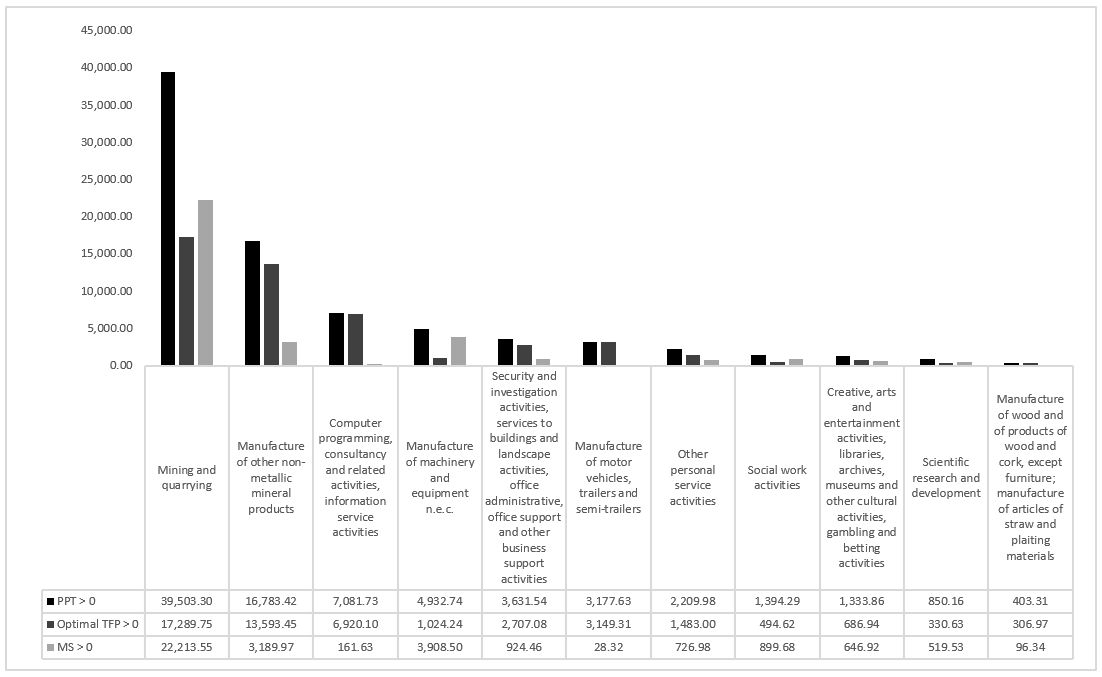1.
Introduction
In 2005, Rodríguez [1] used the Lyapunov-Schmidt method and Brower fixed-point theorem to discuss the following discrete Sturm-Liouville boundary value problem
where λ is the eigenvalue of the corresponding linear problem and the nonlinearity f is bounded.
Furthermore, in 2007, Ma [2] studied the following discrete boundary value problem
where f is subject to the sublinear growth condition
for some 0≤α<1 and A,B∈(0,∞). Additional results to the existence of solutions to the related continuous and discrete problems on the nonresonance and the resonance can be found in [3,4,5,6,7,8,9,10,11,12,13] and the references therein. For example, Li and Shu [14] considered the existence of solutions to the continuous Sturm-Liouville problem with random impulses and boundary value problems using the Dhage's fixed-point theorem and considered the existence of upper and lower solutions to a second-order random impulsive differential equation in [15] using the monotonic iterative method.
Inspired by the above literature, we use the solution set connectivity theory of compact vector field [16] to consider the existence of solutions to discrete resonance problems
where p:[0,T]Z→(0,∞), q:[1,T]Z→R, ¯g:[1,T]Z→R, r(t)>0, t∈[1,T]Z, (λk,ψk) is the eigenpair of the corresponding linear problem
It is worth noting that the difference between the problem (1.1) and the above questions is the eigenvalue that not only appears in the equation but also in the boundary conditions, which causes us considerable difficulties. Furthermore, it should be noted that these problems also apply to a number of physical problems, including those involving heat conduction, vibrating strings, and so on. For instance, Fulton and Pruess [17] discussed a kind of heat conduction problem, which has the eigenparameter-dependent boundary conditions. However, to discuss this kind of problem, we should know the spectrum of the problem (1.2). Fortunately, in 2016, Gao and Ma [18] obtained the eigenvalue theory of problem (1.2) under the conditions listed as follows:
(A1) δ0:=a0d0−b0c0<0,c0≠0, d1−b1≠0,
(A2) δ1:=a1d1−b1c1>0,c1≠0, b0+d0≠0,
which laid a theoretical foundation for this paper.
Under the conditions (A1) and (A2), we assume the following conditions hold:
(H1) (Sublinear growth condition) f:[1,T]Z×R→R is continuous and there exist α∈[0,1) and A,B∈(0,∞), such that
(H2) (Symbol condition) There exists ω>0, such that
or
(H3) ¯g:[1,T]Z→R satisfies
(H4) f:[1,T]Z×R→R is continuous and
uniformly for t∈[1,T]Z.
The organization of this paper is as follows. In the second section, we construct a completely new inner product space. In the new inner product space, we discuss the basic self-adjointness of the corresponding linear operator and the properties of the eigenpair of (1.2). Finally, under the above properties, the Lyapunov-Schmidit method is used to decompose the inner product space and transform our problem to an equivalent system, that is to say, finding the solutions of (1.1) is equivalent to finding the solutions of this system. Under the sublinear condition and sign conditions on nonlinear terms, an existence result of solutions to the problem (1.1) is obtained using Schauder's fixed-point theorem and the connectivity theories of the solution set of compact vector fields. Based on the first result, the existence of two solutions to the problem (1.1) is also obtained in this section.
2.
Preliminaries
Definition 2.1. ([19]) A linear operator P from the linear space X to itself is called the projection operator, if P2=P.
Lemma 2.2. ([16]) Let C be a bounded closed convex set in Banach space E, T:[α,β]×C→C(α<β) be a continuous compact mapping, then the set
contains a connected branch connecting {α}×C and {β}×C.
Lemma 2.3. ([20])(Schauder) Let D be a bounded convex closed set in E, A:D→D is completely continuous, then A has a fixed point in D.
First, we construct the inner product space needed in this paper.
Let
then Y is a Hilbert space under the following inner product
and its norm is ‖y‖Y:=√⟨y,y⟩Y.
Furthermore, consider the space H:=Y⊕R2. Define the inner product as follows:
which norm is defined as
where ⊤ is transposition to a matrix.
Let
and
For y∗=[y,α,β]⊤, define an operator L:D→H as follows:
where D={[y,α,β]⊤:y∈Y, y0,1=α, yT+1,1=β}. Define S:D→H as follows:
Then, the problem (1.2) is equivalent to the eigenvalue problem as follows:
that is, if (λk,y) is the eigenpair of the problem (1.2), then (λk,y∗) is the eigenpair of the opertor L. Conversely, if (λk,y∗) is the eigenpair of the operator L, then (λk,y) is the eigenpair of the problem (1.2).
Eventually, we define A:D→H as follows:
where F(t,y∗)=F(t,[y,α,β]⊤)=[f(t,y),0,0]⊤. Obviously, the solution of the problem (1.1) is equivalent to the fixed point of the following operator
It can be seen that there is a homomorphism mapping (λk,y)↔(λk,y∗) between the problem (1.1) and the operator Eq (2.2).
Next, we are committed to obtaining the orthogonality of the eigenfunction.
Lemma 2.4. Assume that (λ,y∗) and (μ,z∗) are eigenpairs of L, then
Proof Let y∗=[y,α,β]⊤∈D, z∗=[z,ζ,ρ]⊤∈D, then
Similarly, we have
It can be seen from (2.3) and (2.4)
□
Lemma 2.5. The operator L is the self-adjoint operator in H.
Proof For y∗=[y,α,β]⊤∈D,z∗=[z,ζ,ρ]⊤∈D, we just need to prove that ⟨y∗,Lz∗⟩=⟨Ly∗,z∗⟩. By the definition of inner product in H. we obtain
and
Therefore,
where
and
Moreover, from
and
we have
□
In order to obtain the orthogonality of the eigenfunction, we define a weighted inner product related to the weighted function r(t) in H. First, we define the inner product in Y as ⟨y,z⟩r=T∑t=1r(t)y(t)z(t).
Similarly, the inner product associated with the weight function r(t) in the space H is defined as follows:
Lemma 2.6. (Orthogonality theorem) Assume that (A1) and (A2) hold. If (λ,y∗) and (μ,z∗) are two different eigenpairs corresponding to L, then y∗ and z∗ are orthogonal under the weight inner product related to the weight function r(t).
Proof Assume that (λ,y∗) and (μ,z∗) is the eigenpair of L, then it can be obtained from Lemmas 2.4 and 2.5
Therefore, if λ≠μ, then ⟨y∗,z∗⟩r=0, which implies that y∗ and z∗ are orthogonal to the inner product defined by the weighted function r(t). □
Lemma 2.7. ([18]) Suppose that (A1) and (A2) hold. Then (1.2) has at least T or at most T+2 simple eigenvalues.
In this paper, we consider that λk is a simple eigenvalue, that is, the eigenspace corresponding to each eigenvalue is one-dimensional. Let ψ∗k=[ψk,α,β]⊤∈D be the eigenfunction corresponding to λk, and assume that it satisfies
Denote by L:=L−λkS, then the operator (2.2) is transformed into
Define P:D→D by
Lemma 2.8. P is a projection operator and Im(P)=Ker(L).
Proof Obviously, P is a linear operator, next, we need to prove P2=P.
It can be obtained from the Definition 2.1, P is a projection operator. In addition, Im(P)=span{ψ∗k}=Ker(L). □
Define H:H→H by
Lemma 2.9. H is a projection operator and Im(H)=Im(L).
Proof Obviously, H is a linear operator, next, we need to prove that H2=H.
It can be obtained from Definition 2.1 that H is a projection operator. On the one hand, for any [y,α,β]⊤∈H, we have
thus, Im(H)⊂Im(L). On the other hand, for any y∗∈Im(L), we have
In summary, Im(H)=Im(L). □
Denote that I is a identical operator, then
The restriction of the operator L on L|Im(I−P) is a bijection from Im(I−P) to Im(H). Define M:Im(H)→Im(I−P) by
It can be seen from KerL=span{ψ∗k} that there is a unique decomposition for any y∗=[y,α,β]⊤∈D
where ρ∈R,x∗=[x,α,β]⊤∈Im(I−P).
Lemma 2.10. The operator Eq (2.6) is equivalent to the following system
where α=a0ψk(0)−c0Δψk(0),β=a1ψk(T+1)−c1∇ψk(T+1).
Proof (ⅰ) For any y∗=ρψ∗k+x∗, we have
(ⅱ) Since ⟨Ly∗,ψ∗k⟩=0, we have ⟨Ay∗,ψ∗k⟩=0. Therefore,
Combining (H3) with (2.5), we have
where α=a0ψk(0)−c0Δψk(0),β=a1ψk(T+1)−c1∇ψk(T+1). □
3.
Main results
Let
Obviously,
Lemma 3.1. Supposed that (H1) holds, then there exist constants M0 and M1, such that
where (ρ,x∗) is the solution of (2.7) and satisfies |ρ|≥M0.
Proof Since
we have
Denote that
Furthermore, we have
So, if we let
we have
Thus,
This implies that
□
Lemma 3.2. Suppose that (H1) holds, then there exist constants M0 and Γ, such that
where (ρ,x∗) is the solution of (2.7) and satisfies |ρ|≥M0.
According to Lemma 3.2, choose constant ρ0, such that
Let
Then, for sufficiently large ρ≥ρ0, there is
and for sufficiently small ρ≤−ρ0, there is
Theorem 3.3. Suppose that (A1), (A2) and (H1)–(H3) hold, then there exists a non-empty bounded set Ω¯g⊂R, such that the problem (1.1) has a solution if and only if θ∈Ω¯g. Furthermore, Ω¯g contains θ=0 and has a non-empty interior.
Proof We prove only the case of (1.3) in (H2), and the case of (1.4) can be similarly proved.
From (1.3) and (3.2)–(3.5), it is not difficult to see that
for sufficiently large ρ≥ρ0 and for sufficiently small ρ≤−ρ0,
Therefore, if ρ≥ρ0 is sufficiently large,
if ρ≤−ρ0 is sufficiently small,
Let
Define Tρ:Im(I−P)→Im(I−P) by
Obviously, Tρ is completely continuous. By (3.1), for x∗∈C and ρ∈[−ρ0,ρ0],
i.e.,
According to Schauder's fixed point theorem, Tρ has a fixed point on C, such that Tρx∗=x∗. It can be seen from Lemma 2.10 that the problem (1.1) is equivalent to the following system
where
At this time, the Ω¯g in Theorem 3.3 can be given by Ω¯g=Ψ(S¯g). There exists a solution to the problem (1.1) for θ∈Ω¯g.
From (3.6), (3.7) and A+∪A−≠∅, we can deduce that for any x∗∈K
Thus,
According to Lemma 2.2, S¯g⊂RׯBρ0 contains a connected branch ξ−ρ0,ρ0 connecting {−ρ0}×C and {ρ0}×C. Combined with (3.8), Ω¯g contains θ=0 and has a non-empty interior. □
Theorem 3.4. Suppose that (A1), (A2), (H2)–(H4) hold. Ω¯g as shown in Theorem 3.3, then there exists a nonempty set Ω∗¯g⊂Ω¯g∖{0}, such that problem (1.1) has at least two solutions for θ∈Ω∗¯g.
Proof We prove only the case of (1.3), and the case of (1.4) can be similarly proved. Since the condition (H4) implies that (H1), using Theorem 3.3, we know that there exists ρ0>0, such that
Let
then δ>0.
Next, we prove that problem (1.1) has at least two solutions for any θ∈(0,δ).
Let
By (H4), there exists a constant A0 such that
Similar to the derivation of Theorem 3.3, there exists ρ∗>ρ0 such that the following results hold:
(ⅰ) For ρ≥ρ∗, there is
(ⅱ) For ρ≤−ρ∗, there is
Let
According to (H4), (3.9) and (3.10), we have
uniformly for x∗∈¯K, i.e.
Therefore, there exists a constant l:l>ρ∗>ρ0>0 such that S¯g contains a connected branch between {−l}×C∗ and {l}×C∗, and
It can be seen from the connectivity of ξ−l,l that there exist (ρ1,x∗1) and (ρ2,x∗2) in ξ−l,l(⊂S¯g), such that
where ρ1∈(−l,ρ0),ρ2∈(ρ0,l). It can be proved that ρ1ψ∗k+x∗1 and ρ2ψ∗k+x∗2 are two different solutions of problem (1.1). □
4.
Example
In this section, we give a concrete example of the application of our major results of Theorems 3.3 and 3.4. We choose T=3,a0,d0,b1,c1=0 and a1,d1,b0,c0=1, which implies that the interval becomes [1,3]Z and the conditions (A1),(A2) hold.
First, we consider the eigenpairs of the corresponding linear problem
Define the equivalent matrix of (4.1) as follows,
Consequently, Aλy=0 is equivalent to (4.1). Let |Aλ|=0, we have
which are the eigenvalues of (4.1). Next, we choose λ=λ1=−1.4657, then we obtain the corresponding eigenfunction
Example 4.1. Consider the following problem
where
and
Then, for f(t,y(t)), we have |f(t,y(t))|≤3|y(t)|13. If we choose ω=1, yf(t,y)>0 for |y(t)|>1. For ¯g(t), we have 3∑s=1¯g(s)ψ1(s)=0.
Therefore, the problem (4.2) satisfies the conditions (A1),(A2), (H1)–(H3), which implies that the problem (4.2) has at least one solution by Theorem 3.3.
Example 4.2. Consider the following problem
where
and
Then, for f(t,y(t)), we always have yf(t,y)>0 for all y(t)>0 or y(t)<0, f is continuous and satisfies
For ¯g(t), we have 3∑s=1¯g(s)ψ1(s)=0.
Therefore, the problem (4.3) satisfies the conditions (A1),(A2), (H2)–(H4), which implies that the problem (4.3) has at least two solutions by Theorem 3.4.
Use of AI tools declaration
The authors declare that they have not used Artificial Intelligence (AI) tools in the creation of this article.
Acknowledgments
Supported by National Natural Science Foundation of China [Grant No. 11961060] and Natural Science Foundation of Qinghai Province(No.2024-ZJ-931).
Conflict of interest
The authors declare that there are no conflicts of interest.



















 DownLoad:
DownLoad: